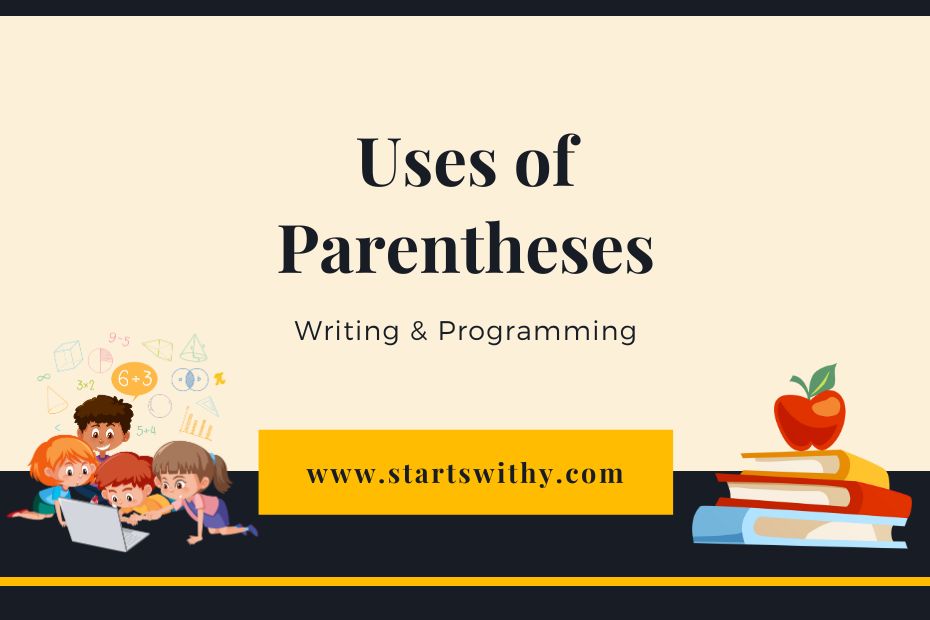Parentheses are a powerful tool in the world of writing, allowing us to add additional information or clarify our thoughts. However, it’s important to use them sparingly and correctly to maintain the flow and clarity of our writing. In this article, I’ll be diving into the dos and don’ts of using parentheses, providing you with a comprehensive guide to mastering this often misunderstood punctuation mark.
When it comes to parentheses, one of the key things to remember is that the information within them should be nonessential or an abrupt change in thought. I’ll be sharing some practical examples and guidelines on when to use parentheses and when to consider alternative options, such as subordinating clauses or standalone sentences. Additionally, I’ll touch on the placement of periods, commas, semicolons, and colons in relation to parentheses, ensuring that your writing remains grammatically correct and polished.
Furthermore, I’ll shed light on the distinction between parentheses and brackets. Although they may look similar, these punctuation marks serve different purposes, with brackets often used to add supplementary information to a quotation. I’ll explain when and how to use brackets effectively, as well as when parentheses within parentheses may be necessary. By the end of this article, you’ll have a solid understanding of how to wield parentheses and brackets confidently, enhancing the clarity and impact of your writing.
What are Parentheses?
Parentheses are punctuation marks used to separate or enclose nonessential information or changes in thought within a sentence. They are represented by a pair of curved lines, like this: ().
Parentheses are a useful tool in writing as they enable the writer to provide additional information, clarification, or examples without interrupting the flow of the main sentence. They can be used to include information that is not essential to the understanding of the main sentence, but still contributes to the overall context.
Here are a few key points to keep in mind when using parentheses:
- Nonessential Information: Parentheses are primarily used to enclose nonessential information within a sentence. This could include additional details, examples, or explanations that are not crucial to the main point of the sentence.
- Sudden Changes in Thought: Parentheses can also be used to indicate abrupt changes in thought or to insert a related but separate idea within a sentence. They act as a visual marker, helping to separate the additional information from the main sentence.
- Standalone Sentences: In some cases, the content enclosed within parentheses may form a complete sentence on its own. In such instances, a period is placed inside the closing parenthesis.
- Punctuation Placement: When using parentheses, it’s important to consider the placement of punctuation marks. If the words within parentheses form a complete sentence, the period is placed inside the closing parenthesis. However, if the words are not a complete sentence, the period is placed outside the closing parenthesis.
Understanding how to effectively use parentheses in writing is essential for conveying information clearly and concisely. They provide an opportunity to include additional context or related thoughts without disrupting the main flow of the sentence. By following these guidelines, you can use parentheses effectively in your writing.
When should you use parentheses?
Parentheses are an important punctuation mark that can be used to enhance your writing by providing additional information or clarifying certain points. Knowing when to use parentheses can help you convey your message more effectively. In this section, I’ll discuss the various situations where it is appropriate to use parentheses.
Providing Extra Information or Examples
Parentheses can be used to enclose nonessential information or examples that provide extra context or clarification to a sentence. For example:
- She was feeling tired (after her long trip) and decided to take a nap.
- The concert was canceled (due to bad weather), disappointing many fans.
By using parentheses in these instances, you can add relevant details without interrupting the flow of the main sentence.
Inserting Citations or References
If you need to include citations or references within your text, parentheses can be used to enclose them. For example:
- According to a recent study (Smith et al., 2021), the new treatment shows promising results.
- The famous quote by Albert Einstein (“Imagination is more important than knowledge) resonates with many creatives.
By using parentheses in these cases, you can attribute the information or quote to its original source.
Indicating Numbers or Dates
Parentheses can also be used to indicate numbers or dates within a sentence, especially when providing additional context. For example:
- The company achieved record sales ($10 million) last quarter.
- The event will take place on Monday (December 15th).
In both of these examples, parentheses help provide specific details without disrupting the overall sentence structure.
Remember, parentheses should only be used when necessary and in moderation. Overusing or misusing parentheses can make your writing appear cluttered or unclear. It’s always a good idea to read your sentences aloud to ensure that the use of parentheses enhances your writing and doesn’t interrupt the natural flow.
So, by using parentheses strategically, you can effectively communicate additional information, provide citations, and indicate specific details within your writing, enhancing both clarity and readability.
The History of Parentheses
Parentheses, also known as round brackets or simply brackets, have a long and fascinating history in the world of writing and punctuation. They were first introduced in ancient Greece, around the 4th century BC, as a way to indicate an interjection or an aside in a text. These early parentheses were curved symbols similar to the ones we use today.
Over the centuries, parentheses became widely adopted across different cultures and languages. In the Middle Ages, scholars and scribes started using parentheses to enclose additional commentary or explanations within a sentence. This allowed them to add extra information without disrupting the flow of the main text.
In printed books, the use of parentheses became more prevalent during the Renaissance. Writers like William Shakespeare and John Milton employed parentheses to insert stage directions, provide insight into characters’ thoughts, or clarify ambiguous phrases. Parentheses became an indispensable tool for authors to enhance the reader’s understanding and add depth to their works.
In modern times, the use of parentheses has expanded further. They are now commonly used in legal writing to enclose citations, references, or explanations of legal terms. Parentheses are also widely used in scientific writing, where they serve to clarify abbreviations, provide additional data or context, or indicate footnotes.
Throughout history, parentheses have evolved from simple punctuation marks to powerful tools for organizing and clarifying written information. Their versatility and usefulness have made them an essential part of effective communication.
And that brings us to the many ways parentheses can be used in writing today. From providing additional information and examples to indicating citations and references, parentheses continue to serve writers in enhancing clarity and readability in various contexts. The key lies in using parentheses strategically and in moderation, ensuring that they add value to the text without overwhelming it.
Next, let’s dive deeper into the specific situations where parentheses can be effectively employed in writing.
Parentheses examples
Parentheses, also known as round brackets, are a versatile punctuation mark used to enclose words or figures that clarify or provide additional information in a sentence. They offer a way to include asides or explanations without disrupting the flow of the main idea.
Here are a few examples of how parentheses can be used effectively in writing:
- Clarification: Sometimes, we need to provide further explanation or definition within a sentence. For instance, “The experiment showed significant results (p<0.05), indicating a statistically significant effect.” In this example, the information in parentheses adds clarity by specifying the significance level.
- Asides: Parentheses can be used to include additional thoughts or comments without interrupting the main point. For example, “The study participants (n=1000) completed a series of questionnaires.” The inclusion of the number of participants (n=1000) is an aside that helps provide context without being the focus of the sentence.
- Citations and References: In academic or scientific writing, parentheses are commonly used to cite sources or provide references. For instance, “According to recent studies (Smith et al., 2021), the effects of climate change are becoming increasingly evident.” Here, the citation in parentheses acknowledges the source of the information.
- Abbreviations: Parentheses can also be used to introduce or explain abbreviations. For example, “The International Monetary Fund (IMF) plays a crucial role in global financial stability.” The inclusion of the abbreviation IMF in parentheses ensures that readers understand its meaning.
Remember, parentheses are a valuable tool for enhancing clarity and readability in your writing. By using them appropriately, you can provide additional information or clarification without disrupting the flow of your main message. So, embrace the versatility of parentheses and harness their power to enhance your writing.
Different Types of Parentheses
Round Parentheses
Round parentheses, also known as curved brackets, are the most commonly used form of parentheses in writing. They have a distinctive curved shape that sets them apart from other types of brackets.
Round parentheses are often used to enclose additional information or clarifications within a sentence. They can be used to add emphasis, provide examples, or offer asides that are related to the main idea but not crucial to the overall message.
For example:
- The survey (which was conducted last month) revealed some interesting findings.
- The new product (available in three different colors) is attracting a lot of attention.
Square Brackets
Square brackets, also known as box brackets, are another type of parentheses that are less commonly used in writing. They have a square or box-like shape, which distinguishes them from round parentheses.
Square brackets are typically used to insert additional information or modifications into a direct quotation. They are often used to make the original quote more clear or to provide context that was not present in the original text.
For example:
- “I am [always] impressed by his dedication to his work.”
- The witness stated, “[He] was not present at the scene of the crime.”
It’s important to note that while round parentheses are more versatile and commonly used, square brackets have their own specific purposes, particularly in the realm of quotations.
By understanding the different types of parentheses and how they are used, writers can effectively convey additional information, clarify statements, and add context to their writing. Remember to use parentheses sparingly and strategically, so as not to overwhelm or confuse the reader.
Understanding Parentheses in Mathematics
In this section, I’ll explain the importance of parentheses in mathematics and how they are used to ensure the correct order of operations and clarify equations.
Order of Operations
Parentheses play a crucial role in the order of operations in mathematics. When solving mathematical expressions or equations, it is essential to follow a specific order to obtain the correct answer. This order is typically represented by the acronym PEMDAS, which stands for:
- Parentheses
- Exponents
- Multiplication and Division (from left to right)
- Addition and Subtraction (from left to right)
The use of parentheses allows us to override the regular order of operations and prioritize certain calculations. By enclosing parts of an equation in parentheses, we indicate that those calculations should be performed first.
For example, consider the equation: 6 + 3 * 2. According to the order of operations, we would perform the multiplication before the addition, resulting in an answer of 12. However, if we include parentheses like this: 6 + (3 * 2), the multiplication would be performed first, giving us an answer of 12.
Using Parentheses in Equations
Parentheses are also used to clarify equations and make them easier to understand. They can be used to indicate grouping, show the relationship between different parts of an equation, or highlight certain calculations.
Here are a few scenarios where parentheses are commonly used in equations:
- Grouping Terms: When dealing with complex equations or expressions, parentheses are used to group terms together. This helps to avoid confusion and ensures that the equation is correctly interpreted.
Example: (2 + x) * 3
- Negative Numbers: Parentheses are used to indicate negative numbers in equations. By enclosing a number within parentheses and placing a negative sign outside, we can clearly distinguish negative values from positive ones.
Example: 5 – (-3)
- Fractional Expressions: Parentheses are often used to express fractions within equations. By enclosing the numerator and denominator in parentheses, we can clearly indicate the division operation.
Example: (x + 2) / (y – 1)
By using parentheses strategically in equations, we can eliminate ambiguity and ensure that our mathematical expressions are interpreted correctly.
Parentheses in Writing
Parentheses, also known as round brackets, play a crucial role in enhancing clarity and providing additional information in writing. As an experienced writer, I understand the importance of using parentheses strategically to convey meaning effectively.
One common use of parentheses in writing is to enclose additional information or clarifications within a sentence. They allow for the insertion of relevant details without disrupting the flow of the main idea. For example, consider the sentence: “The event (scheduled for next week) has been postponed due to unforeseen circumstances.” Here, the information within the parentheses provides important context that adds clarity to the sentence.
Another way parentheses can be utilized is to indicate an alternate way of expressing a concept or provide an optional word choice. For instance, in technical or scientific writing, parentheses can be used to present abbreviations or synonyms for terms that may be less familiar to readers. This allows for a smoother reading experience without compromising accuracy or understanding.
In addition to these uses, parentheses can also be employed to insert citations or references. In academic writing, parentheses are often used for in-text citations to acknowledge the source of information or to provide additional context. For example, the MLA style guide requires the use of parentheses to include the author’s last name and the page number when referencing sources.
It is important to note that while parentheses serve a valuable purpose in writing, they should not be overused. It is best to use them sparingly for small asides or supplementary information. Overwhelming readers with too many parenthetical statements can make the text difficult to follow.
Parentheses in writing enable us to provide additional information, clarify statements, and add context to our writing. By using parentheses strategically, we can enhance the readability and comprehensibility of our work. Remember to use parentheses judiciously, keeping the reader’s understanding and engagement in mind.
Parentheses in Programming
In programming, parentheses play a crucial role in different contexts. Let’s explore two important areas where parentheses are commonly used: mathematical expressions and function calls.
Parentheses in Mathematical Expressions
Parentheses in mathematical expressions are used to control the order of operations and ensure the correct evaluation of the expression. By enclosing certain parts of the expression in parentheses, you can prioritize their evaluation and override the default rules of operator precedence.
For example, consider the following equation:
result = 3 + 4 * 2
Without parentheses, the multiplication operation would be performed first, resulting in 11. However, by using parentheses, you can change the order of evaluation:
result = (3 + 4) * 2
With the parentheses, the addition operation is performed first, resulting in 14. This shows how parentheses can alter the outcome of a mathematical expression based on the desired order of operations.
Parentheses in Function Calls
In programming, parentheses are used to invoke or call functions. Functions are blocks of code that perform specific tasks and can accept parameters. By enclosing the input values or arguments inside parentheses, you can pass them to the function for processing.
For example, consider the following function:
function greet(name) {
console.log("Hello, " + name + "!");
}
To call the greet function and pass the name “John” as an argument, you would use parentheses:
greet("John");
The parentheses surrounding the argument “John” indicate that you are invoking the greet function and providing it with the necessary input. This allows the function to execute and produce the desired output, which in this case would be “Hello, John!” printed to the console.
By using parentheses in function calls, you can pass the required information to functions and utilize their functionality in your programs.
To sum up, parentheses play a vital role in programming, particularly in mathematical expressions and function calls. Whether it’s controlling the order of operations or passing arguments to functions, understanding and utilizing parentheses correctly enhances the clarity and functionality of your code.
Conclusion
Understanding the uses of parentheses is essential for effective writing and programming. In writing, round parentheses are commonly used to provide additional information or clarifications within a sentence. Square brackets, although less commonly used, are used to insert additional information or modifications into a direct quotation. By utilizing the appropriate type of parentheses, writers can enhance the clarity and context of their writing.
In programming, parentheses play a crucial role in controlling the order of operations in mathematical expressions and passing arguments to functions. They allow programmers to specify the desired order of operations and ensure that functions receive the necessary information to execute correctly. By understanding how to use parentheses in programming, developers can create code that is both functional and efficient.
Whether in writing or programming, mastering the use of parentheses is key to conveying information effectively and ensuring the accuracy and functionality of your work. By employing parentheses correctly, you can enhance the clarity and functionality of your writing and code. So, remember to embrace parentheses as a valuable tool in your writing and programming endeavors.




